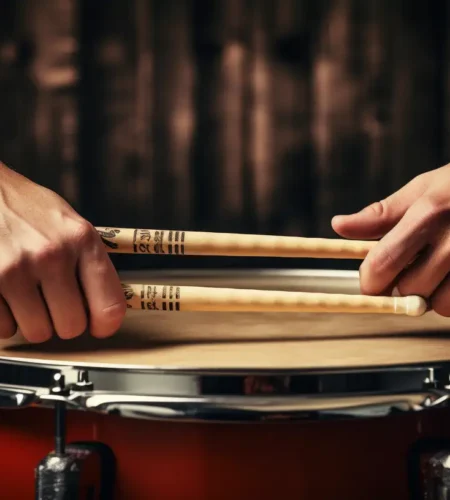You might not realize it, but the way you hold a drumstick can dramatically affect the sound you produce and the ease with which you play. As you stand poised to strike the drum, it’s essential to consider the balance and grip of the drumstick in your hand. It’s not just about holding on; it’s about discovering the fulcrum point that allows the stick to rebound naturally, affording you both control and fluidity.
The matched, traditional, American, German, and French grips each offer unique benefits tailored to different styles and preferences. And while you might be eager to just start hitting those drums, taking the time to fine-tune your grip is an investment in your musical future. The secret to unlocking your full potential as a drummer lies in the subtle interplay between your hands and the sticks, a topic that offers more depth than you might expect.
So, let’s explore the pivotal elements that will elevate your drumming technique, shall we?
Key Takeaways
- Finding the fulcrum is essential for natural rebound and control in drumming.
- The matched grip, with the thumb and index finger around the fulcrum, enhances control and balance.
- Traditional grip, with a different hold for one stick, provides finesse and subtlety for snare drum work.
- American grip, with relaxed hands and balance point nestled in the hand’s crook, is versatile for different drumming styles.
Finding the Fulcrum
Have you ever wondered why some drummers make playing look effortless? It often starts with mastering the fulcrum, the key to a natural rebound and control of your drumstick. To find this balance point, hold the drumstick between your index finger and thumb, allowing it to pivot. This spot is where the stick feels the most comfortable and produces the longest bounce.
Experiment with different positions to discover the most natural fit for your hand. You might find placing the drumstick between your middle finger and thumb feels better, or perhaps a combination of fingers works best. It’s crucial you don’t grip the fulcrum too low or too high. Holding it too low will reduce the stick’s bounce, while too high can compromise your control. You’re seeking that sweet spot that lets the stick do most of the work for you.
As you play, you might adjust your grip unknowingly to suit the style of the song, whether you’re seeking a powerful backbeat or a light, swift roll. If you’re struggling to find the right balance, don’t hesitate to ask for advice. Seasoned drummers or instructors can offer valuable tips on supporting the stick to enhance your drumming technique.
Mastering the Matched Grip
Once you’ve found the comfortable fulcrum point on your drumstick, it’s time to focus on mastering the matched grip to further refine your technique. Unlike the traditional grip, a matched grip involves holding both sticks in the same manner, which can enhance your control and balance.
With a matched grip, you’ll want to place the thumb and index finger around the fulcrum, allowing the stick to pivot freely. Your remaining fingers, especially the ring and pinky fingers, should lightly hug the stick for additional support. The pressure you apply with your thumb and index finger should be firm but relaxed to prevent fatigue.
Here’s a brief comparison to help you understand the differences:
| Feature | Matched Grip | Traditional Grip | Importance |
|---|---|---|---|
| Thumb Position | Opposes index finger | Along the side of the stick | Affects stick pivot |
| Index Finger Role | Applies pressure to stick | Guides the stick | Impacts control |
| Ring & Pinky Fingers | Lightly support the stick | Less involved | Provides additional grip |
| Symmetry | Both hands use a similar grip | Different grips for each hand | Eases learning of new beats |
Understanding the Traditional Grip
In contrast to the matched grip, the traditional grip requires you to hold one stick differently, with the thumb and index finger wrapping around the stick, and the stick resting against the cuticle of the ring finger for added stability. This grip was developed for playing the snare drum when it was slung at an angle due to the marching needs of military drummers.
It allows for a different kind of finesse and subtlety in playing, especially for delicate snare drum work.
While the matched grip uses an overhand grip with both hands, the traditional grip has a unique feel and may take some time to master. Your left hand (or right if you’re left-handed) will handle the stick with the palm facing up, using a combination of the thumb, index, and ring finger to control the stick’s movement. The right hand continues to use an overhand grip as it would in matched grip.
Playing With American Grip
While the traditional grip offers a unique approach to snare drum finesse, the American grip steps in as a versatile choice for various drumming styles. You’ll find this grip especially useful as it blends the best aspects of both French and German grips, providing you with a comfortable, yet controlled way to play.
When using the American grip, imagine the following:
- Your palms facing each other in a natural, relaxed position.
- Drumsticks held firmly yet gently, with your index fingers pointing forward and thumbs resting on the sides.
- The balance point of the stick nestled in the crook of your hand, ensuring optimal control.
- Wrist motion flows smoothly, allowing for a wide range of dynamics.
- A synergy between finger and wrist movements, creating an effortless playing experience.
To master the American grip, focus on keeping your hands relaxed. This will help you maintain fluid motion and reduce fatigue during long playing sessions. Experiment with different hand positions and finger placements to discover what feels most comfortable. Remember, the American grip is all about balance and adaptability, enabling you to play across different drumming styles with ease.
Techniques of the German Grip
Adopting the German grip, position your palms downward and secure the drumsticks using your thumb and index finger at their balance point for powerful, controlled strikes. Unlike a traditional grip, where each hand holds a stick differently, with the German grip – a form of matched grip – both hands mirror each other. This symmetrical approach is beneficial when you’re aiming for consistent power and volume across the kit.
Turn your palms so they face the ground and allow your fingers to wrap comfortably around the sticks. Your hands should be relaxed, but you’ll need to use your wrists to generate the force behind each hit. Keep your elbows naturally out to the sides to create a stable base for your movements.
The German grip is particularly effective when you’re playing louder genres like rock or heavy metal. It provides the robust power necessary for emphatic beats. The sticks should form roughly a 90-degree angle against the drum surface, ensuring optimal rebound and sound projection.
Exploring the French Grip
After mastering the German grip’s powerful strikes, you might explore the French grip for its finesse and control in your drumming technique. The French grip is especially useful for styles that require a delicate touch, like jazz or intricate rock patterns.
To adopt this grip, you’ll need to turn your hands so your palms face each other, with your thumbs on top of the drumsticks.
Imagine the following as you transition to the French grip:
- Your thumbs rest on top of the sticks, leading the motion like a conductor’s baton.
- Your index finger curls lightly around the stick, ready to guide with precision.
- The sticks feel like an extension of your arms, balanced and poised for action.
- Your hands, turned inward, seem to speak to each other in a silent drumming dialogue.
- Each finger is poised to add its own nuance to the rhythm, with control at your fingertips.
Using the French grip, your index finger becomes crucial for nuanced finger control, allowing you to execute intricate rhythms and dynamic changes with ease. Practice this grip to bring a new level of sophistication to your playing.
Frequently Asked Questions
Is There a Proper Way to Hold Drumsticks?
Yes, there’s a proper way to hold drumsticks that balances control and comfort. You’ll find the fulcrum, choose your grip, and ensure your hands are relaxed for the best drumming technique.
What Is the Best Grip for Drumsticks?
The best grip for you depends on your playing style and comfort. Try matched, French, or German grips to see which enhances your control and fluidity on the drums.
Why Do Drummers Hold Their Sticks Sideways?
You’re seeing drummers hold sticks sideways primarily for style and technique, like in traditional grip, which offers better wrist motion and finesse, particularly useful in jazz or marching band performances.
How Do You Hold the DR Sticks?
You’ve asked about drumstick handling; here’s the gist: find the fulcrum for balance, then choose a grip—French, German, or American—to suit your play style. It’s all about comfort and control.


Comments